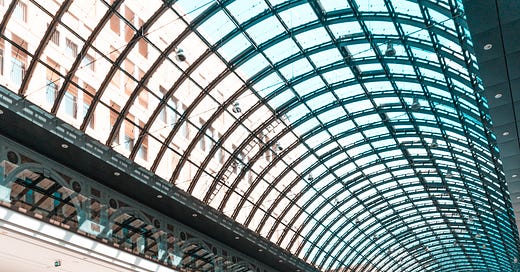Would You Live In a Mall?
Turning Office and Commercial Space into Homes in the Post-Covid World
Photo by Bhawin Jagad on Unsplash
Living in the densely packed suburbs that surround New York City, we are a stone’s throw from a big highway with lots of malls and shopping centers. On the 14-mile strip of highways between my house and New York City’s George Washington Bridge, you can find everything from Home Depot to Macy’s to IKEA to Old Navy. There are malls that cater to rich people who like designer labels, and there are outlets that appeal to those on a budget. For decades, these major roads to New York City have been the home of massive cement structures built for consumption.
But these malls and shopping centers, like the Egyptian pyramids, are lying dormant and shuttered. They were struggling before Covid, but went extinct when the masks went on. Now, as you drive down the highway, store after store is closed.
Developers are trying to find new uses for these properties. In New York City, architects are trying to find ways to turn office buildings into commercial space. (Super interesting article in the New York Times about this.) Here too, the plan is to turn the old malls and shopping centers into residential properties. While these new housing units are much needed, especially for seniors and disabled people, there are some worries about whether the infrastructure can support increased density.
With stores like Gap, Banana Republic, Saks, Tiffanys, and Apple, Garden State Plaza aims for the middle class to upper middle class shopper. I buy Ian’s Old Navy jeans there and get new shirts for Steve at Macy’s. This mall is currently being deconstructed and turned into a “mixed-use lifestyle destination” — an outdoor mall with entertainment spots and housing. (Photo above.)
Lord and Taylor, one of the oldest department stores in the country, went belly up during Covid. With nobody interested in moving into that huge space, developers are also going to turn it into housing.
Barnes and Noble is shutting down their huge store on this same highway, because the owners of the building are turning it into housing for very disabled people.
What’s going to happen to the old Kmart, Stop and Shop, Bed Bath and Beyond and all the other abandoned stores on the highway? Rather turning into another Halloween pop-up stores, they may also become high-density housing.
More affordable housing has been needed for a long time. Putting people in vacant shopping malls would seem to be a creative use for wasted space. These buildings can be redesigned with communal spaces that would be ideal for isolated seniors. New bussing systems can get them to the supermarket. Old folks are too deaf to care that they’re living on a major highway.
Currently, there’s a twenty-year waiting list for housing for disabled people in New Jersey. Wheelchair-friendly facilities and with large common areas and office space for support staff is desperately needed. Housing along the highway without NIMBY-type neighbors is ideal for this group.
20-somethings also need housing. Rents are astronomical. Many will suffer from long term economic ramifications due to learning loss. Already, 60 million Americans live in multi-generational housing. Without more affordable housing, our kids will be living with us forever. This group will live anywhere available, even in a former shopping mall.
Downsides? Greater housing stock will lower the cost of existing homes, so homeowners (hello!) might have less money for retirement. The increase in residents might overwhelm local roads. If young families move into these mall homes, the local schools might not have the classroom space for all the new kids. If things become uncomfortable, middle class families might move out.
But, truthfully, nobody knows how all these changes will pan out. All we know for sure is that change is happening.
Covid knocked over the first domino in a long chain of dominos. Our kids are different. Schools are different. Work is different. Housing will be different. Let’s just make sure that these differences are improvements.



